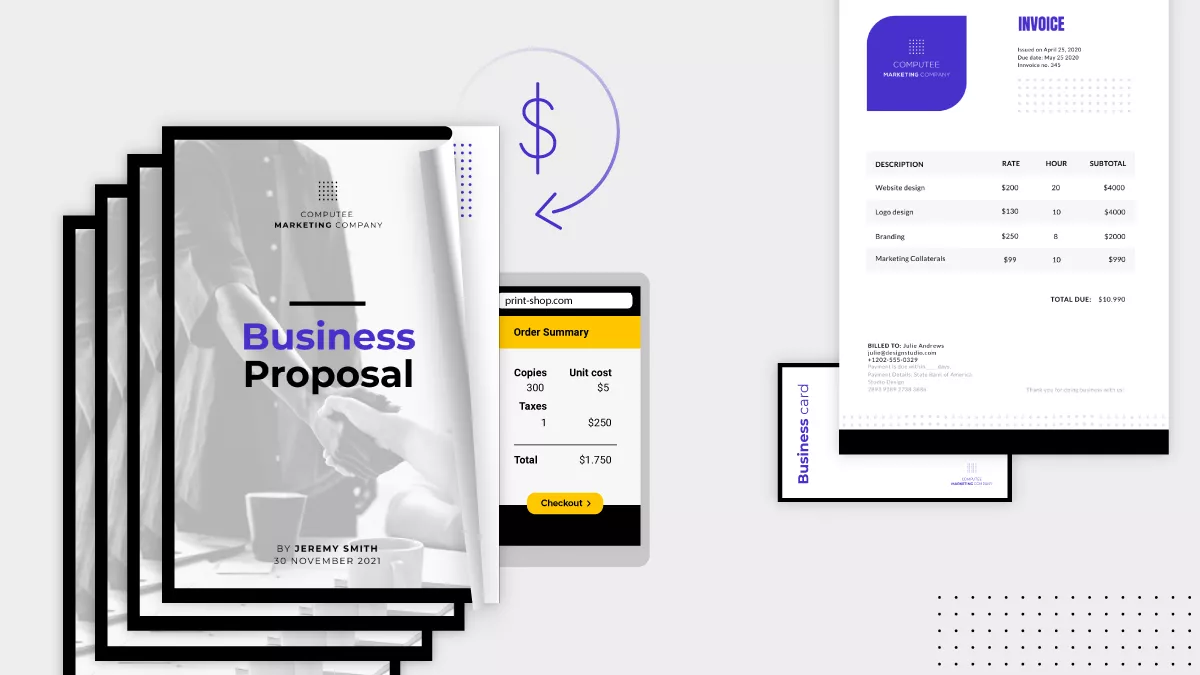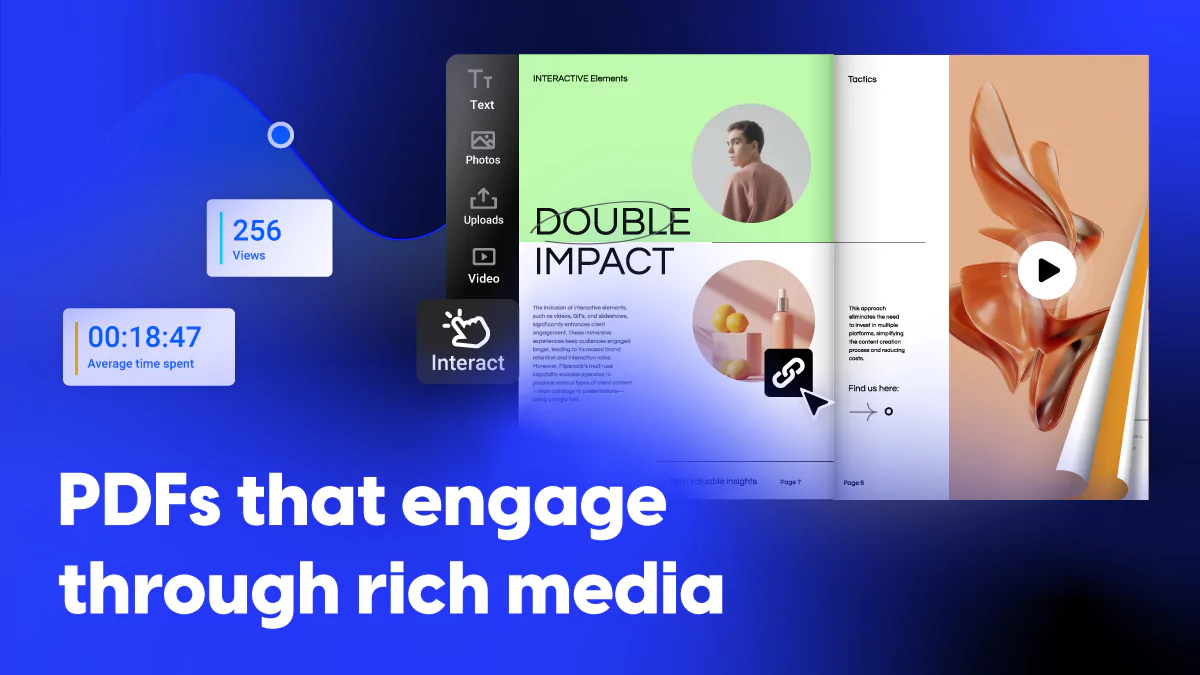Is your company spending too much on print? Useful tips for budget cuts
Even though printing has been around for ages, it doesn’t mean we should keep it around for years to come. The negative impact printing has on the environment and your company’s budget should get you thinking about new strategies to implement when sharing information. Be it internally or externally.
In this article, I’ll walk you through hard-to-believe printing costs statistics and how you can reduce them for your company. Once you calculate how many resources go into everything-print, you’ll notice that it’s not only money that gets wasted; but also time and effort that could be used for doing actual work.
Stick around if you want to learn more about this subject, and read about actionable tips for reducing printing costs. Stick around if you want to learn more about this subject, and read about actionable tips for reducing printing costs. The solution might be as obvious as using a QR code generator or esignature services, and might be easier to implement than you’d think.
Surprising statistics about printing costs
Before getting to the part about reducing printing costs, we should see what the concern is about. Is it really that detrimental to the company’s budget and resources, or can you continue in the same manner? Let’s start with the most important one, which is affecting your IT department, as well.
1. Printer-related issues account for half of Help Desk calls
If this doesn’t catch your attention, I don’t know what will. We can all agree that printing is an essential part of an office and later on; you’ll find out exactly how much employees print on average per year.
A study conducted by Gartner suggests that around 50% of help desk calls are related to print. This means that your IT department is constantly at the back and call of any printer issues; thus decreasing productivity when it comes to achieving their daily tasks.
Think about the numerous other tasks the IT department could be doing instead of dealing with printer-related issues. That’s not to say you should dismiss print completely, but maybe you could invest in higher-quality equipment; which will have a longer lifespan and will save you time in repairing a jammed printer.
2. An average employee prints 10,000 pages in a year
Think of it as 27 printed pages every day. It’s not so bad, until we mention that 17% of these papers are not used at all. This translates to 725 dollars/year with 10,000 pages/employee. It doesn’t sound so affordable anymore, does it? By eliminating this wasteful printing and adopting an effective solution in your office, you can visibly reduce your operational costs.

You can invest in a high quality printer, practice double-sided printing; and only focus on documents that absolutely need to be printed. The other option is related to going paperless, which of course, is the ideal scenario for every environmentalist.
3. 10-30% of potential savings are missed while ignoring printing costs
The Gartner Group has noticed a potential increase in a company’s savings, up to 30%. The key is for companies to concentrate on their financial waste and start implementing print management solutions to reduce the waste generated by print.
4. 90% of companies don’t track their printing costs
Every penny that your company spends should be tracked. Why? Because otherwise, you end up in a situation where a big chunk of your budget is spent on printing, and you don’t even know.
Tracking what you spend is the first step to saving up more efficiently. With all the expenses written down, you can make better decisions based on that information; and not guess anything as important as this. Tracking printing expenses should be a crucial part of your budget planning; so you can maximize your profit in the long run.
5. Over the last 20 years, paper use has doubled
If 20 years ago, in the US, people and companies consumed 92 million tons of paper, today, that number has more than doubled. With 208 million tons of paper used every year for print; we can predict the climatic disaster this will bring upon us soon enough. Looking at deforestation, air pollution and enormous water resources used in creating every sheet of paper; we notice just a few visible consequences.
Every year more than 24 billion newspapers, 350 million magazines and 2 billion books are published in the US. Imagine the huge impact digitalization would have on these industries. More and more magazines are making the switch to digital, like Cosmopolitan, and their subscriptions have gone up by 70%, over the past two years.

The real cost of print
Now that we know how much money gets wasted on print and we covered the financial cost of this topic; we can move on to the real cost. That encapsulates the expenses of searching for misfiled printed documents, the effort to fix jammed-up printers; and the negative impact on productivity.
According to PricewaterhouseCoopers, the average company spends about $20 in labor to file each paper document; approximately $120 in labor searching for each misfiled document, and $220 in re-creation of a document. It’s a lot of money for something that could be digitized, am I right?
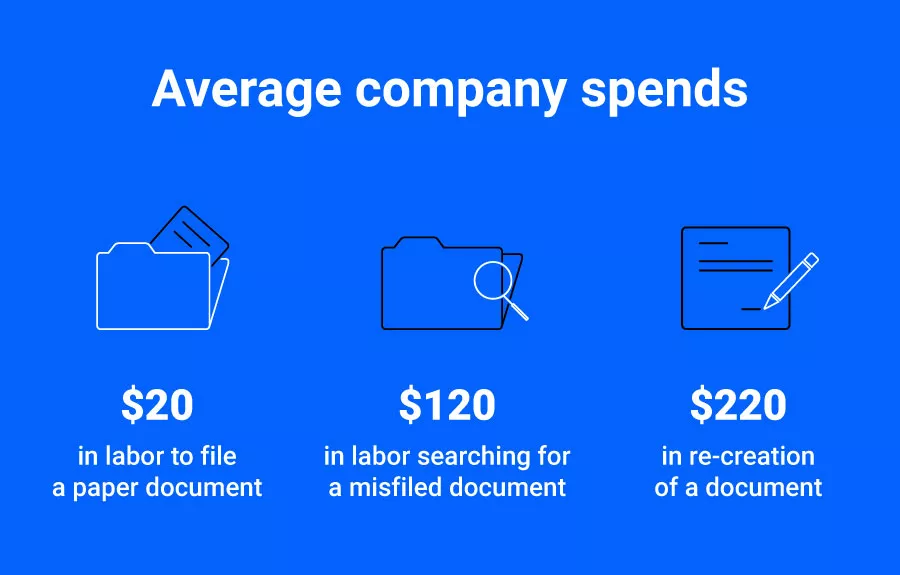
Not to mention that paper documents have a negative impact on productivity. According to studies, workers lose an average of $14,000 in productivity each year due to difficulty in locating data needed to fulfill their jobs. When you think about it this way, the quest of finding an alternative to print is more and more urgent.
However, there is a greater benefit than cost savings. Instead of filing, shredding, and trying to locate documents, time may be better spent marketing the company’s products and services and providing outstanding customer support. For example, you can improve customer experience using IVR software and thus eliminate the need for a live agent manually to respond to incoming calls. It allows businesses of all sizes to offer a high level of “always-on” customer self-service options in addition to connecting callers to the appropriate agents when needed. Employees may focus on developing the top line of the firm with less paper and less time spent managing it.
It’s simple to reduce waste. According to industry surveys, boosting the use of email and online services, as well as completing double-sided copying, can lower paper usage by 25% for the average organization. But we’ll get into more details about this topic later in the article.
Is your school wasting too much paper?
Maybe you haven’t thought about this until now, but schools may produce even more paper waste than companies. With so many textbooks, study guides, manuals, homework assignments, exams, and handouts, the printing habit is at its peak!
According to the NYC Government, each student, teacher, and staff member in one NYC school dumped 28 pounds of paper during the school year. Let’s do a quick math exercise. If one pound of paper equals 100 sheets, then we find out that in one year, a single school produces 2,800 sheets of paper per person. If we’re talking about the number of trees, that’s one whole tree.
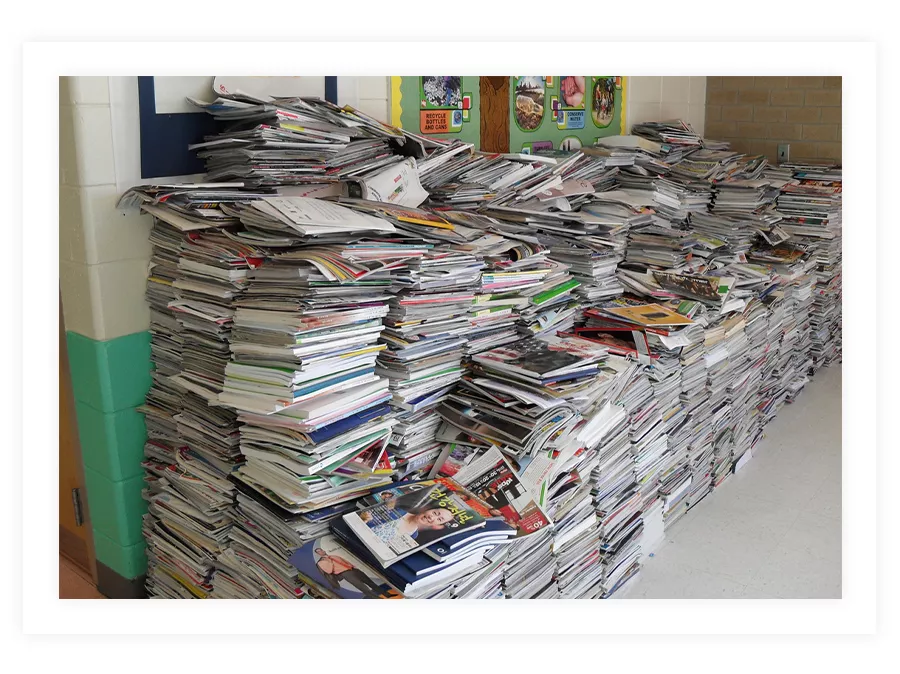
To put things into perspective, did you know that at Staples, a pallet (200,000 sheets) costs 1,400$? Let’s say your school district has 10,000 students. In simple math, that’s around 200,000$ per year, spent on paper only.
A simple alternative to print is digital tools, used either for quizzes and questions, with real-time scoring, or for presentations. Check out Flipsnack’s educational plan to learn more about how you can use this design & publishing tool to your students’ benefit and be eco-friendly in a visible way.
Benefits of choosing scan over copy in your school
Save money
The cost of scanning electronic education records is quite straightforward—on average, scanning costs 7–12 cents per page, with the lower the cost per page the larger the project.
For print, aside from the regular expense of buying paper (which averages 2,000 sheets per day at 5 cents each); there are additional indirect costs associated with using paper.
Of course, the other related costs are resources used for filing printing documents, the time you use to find lost documents (time is money, after all); and the money spent on office supplies.
Save time
The opposite can be said for scanning, since you can quickly find and share files with the desired audience. Scanned files are indexed and stored, which means they can quickly be tracked down by using keywords.
Focus on data security and backups
Electronic education files give additional security not just against physical theft, such as a locking file cabinet; but also against external threats like hacking or natural catastrophes such as fire and flood.
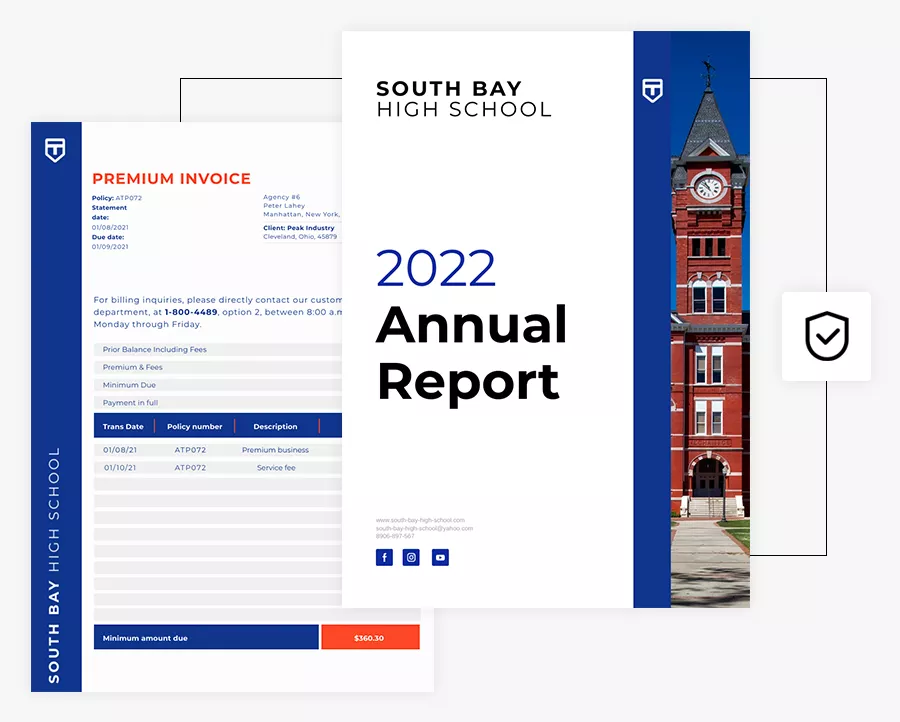
Actionable tips for reducing printing costs
With everything I’ve presented to you so far, I think we can agree that the cost of printing is much higher than your company or your fellow teacher colleagues, students alike might think.
However, if you still want to maintain print as the primary way of spreading information to your audience; then check out these actionable tips in reducing this cost. Don’t worry, these are both easy and small changes that will have a lasting impact.
1. Start using color printing sparingly
By far, this is the one aspect that costs your business or school the most money in regards to printing habits. Color ink cartridges cost a lot, and if you’re honest, you’ll find out that not everything you color print is a necessity. Not every logo, diagram or report needs to be colored in order to be understood. Next time you go to the default way of color printing, take a moment to assess if you can do something different.
Color toner and ink cartridges aren’t the only items that cost a lot of money. Color laser printers in general are substantially more expensive than black and white printers. Take this matter with your managers and see if maybe you can limit the number of color laser printers around the office. Unless there is something that needs to be printed in color; you can make it a common office rule to print in monochrome.
2. Be more open to print on both sides of the paper
This is a very obvious method to reduce the number of pages used for a document. If your corporation has the habit of printing every little announcement and company update, then this is a small adjustment that will cut in half the cost of buying paper/pallets.
Double-sided printing, also known as duplex printing, allows you to print on both sides of a sheet without having to manually remove it, change the side, and reload it into the printer. Set the default setting for all papers printed for internal use to two-sided printing. By doing this, not only you save money on printing; but you also have a good impact on the environment by reducing the amount of trees, water, and energy used to make paper.
3. Use eco-friendly fonts & reduce paper margins
The Arial font is widely used by businesses and people when printing papers. Even though this font appears to be an excellent choice for formal and informal communication alike, it’s not as eco-friendly as other fonts. Some examples would be Century Gothic, Times New Roman, and Ecofont; which help to cut down ink usage by 30% in comparison with Arial.
The decision is up to you: either remain stuck in the old ways of doing print-related tasks, or adopt new methods such as this one and contribute to the environment’s health. Using Century Gothic as your default font is the cheapest and greenest font available. The secret is in its thin letter and light color, which helps decrease the overall print cost.
In regards to the paper margin, you simply have to reduce the default size of 1,25 cm to 0,75 cm. It’s such a subtle difference that no one will be able to tell. This way, you’ll fit more text on a page, reducing the number of pages necessary for printing a document. Don’t waste paper on broader margins and start thinking more about the way you use paper in your business.
4. Rely on scanning and not copying
You might wonder what’s the big difference between these two and what difference does it make? Scanning offers a digital version of a document, while the latter prints the document on another paper.
There’s no real reason why you should copy an already printed document, and it also leaves the recipient with fewer options of how to use it. If you opt for scanning a document, you can easily send it via email, allowing that person to access it from any place and distribute it however they want. A physical copy forces you to either leave it at their desk or fax it to them; which again, uses valuable company resources like ink and electricity.
5. Invest in a high-quality printer
Even though this might be easier said than done, we urge you to consider this aspect of your printing needs. By requesting more quotes from different suppliers, you can get a better understanding of what to look out for when buying a printer and you examine your options.
It all starts with the primary need of your organization. There are a lot of printers available on the market, which offer a lot of features from print, scan, email fax, copy, and more. If you have to print a lot of documents on a daily basis; then all the more reasons to invest in a high-quality printer, which will save you time and money in the long run. If you don’t print pictures that often, then you don’t need a printer with high-quality photo printing capabilities.
It’s up to you to choose between laser printers and inkjet printers. The latter is considerably cheaper than the first one, so its operational cost will be lower. The downside is that they have a shorter lifespan than the laser ones, so it will end up costing you more money. In some cases, purchasing a high-end printer will help you keep the prices low eventually; even if the upfront price is high.
6. Select your paper carefully
If you think about it, everything mentioned in this article points to this: investing more money upfront can save you a lot of money down the road. The same is true for selecting the quality of the paper. Undoubtedly, high quality paper is more expensive; but it also saves you the trouble of a jammed up printer, caused by cheap paper and the reprinting costs.
The prices for paper sheets range depending on their whiteness, weight and coating. However, consider using uncoated paper instead of coated, for a lower price, if you’re on a strict budget. That’s the characteristic where you can compromise, without it being a visible change.
7. Don’t be afraid to go digital
Trying a new thing for the first time can be scary. You don’t know what to expect or how it will turn out in the long run. But I’m here to encourage you to consider what going digital would mean for your business or school. This system is so much easier to implement than you might think. All it takes is a bit of courage and the right tool in order to move all your paper documents in the digital world.
Just how many meetings can be an email, many paper documents can be digital documents, traditional business cards can be digital business cards. Send them and use them however you want, without producing unnecessary waste. Think about the time you’ll save since you won’t have to look for misfiled documents and the data privacy you gain from this switch.
Once you have the majority of your documents in a PDF format, you can easily upload them in Flipsnack, for example. This is a platform where you can create anything from brochures, internal or external newsletters, school assignments; even turn your printed textbooks into ebooks. I won’t lie, it takes a bit of effort until you establish an efficient way to have the information in a PDF format; but it’s a walk in the park from there on.
The advantages of digital documents far outweigh the disadvantages. The impact it has on your budget is shocking, and you could use that extra money for other important projects. Give it a try the next chance you get and you won’t regret it!

A final argument for going digital
With all that being said, the question remains: Why does it matter if you choose print or digital? If you can maximize the profit by reducing printing costs, then you’re already one step ahead of your competitors.
In the end, the shift toward paperless automation has numerous advantages for practically any business, particularly those that rely heavily on forms and contracts. Some examples of such companies are healthcare, financial services, insurance and law firms.

Keeping this in mind, the next logical step would be to assess the digital software options. Depending on your company’s needs, you can check out a design & publishing platform like Flipsnack. Create any type of digital publication from brochures to catalogs, internal and external newsletters, school assignments, and so much more.
Sharing this digital publication is even easier than designing it. Simply select the option which best suits your purpose: via email, full-view link, website embed or QR codes for your restaurant menu. Et voilà, you’re done! Contributing to a better environment, while saving costs.
